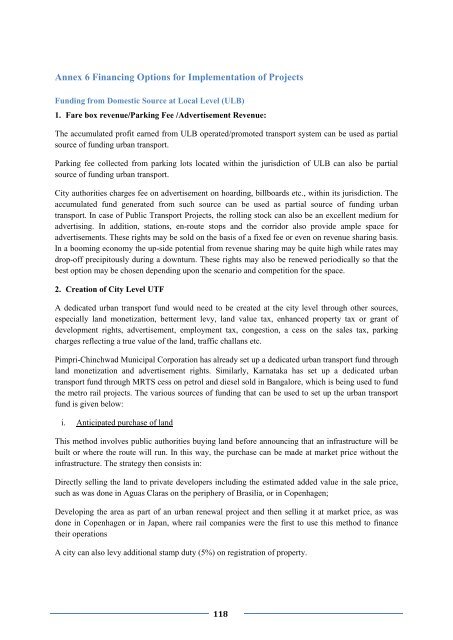Toolkits for Urban Transport Development - UNEP
Toolkits for Urban Transport Development - UNEP
Toolkits for Urban Transport Development - UNEP
You also want an ePaper? Increase the reach of your titles
YUMPU automatically turns print PDFs into web optimized ePapers that Google loves.
Annex 6 Financing Options <strong>for</strong> Implementation of Projects<br />
Funding from Domestic Source at Local Level (ULB)<br />
1. Fare box revenue/Parking Fee /Advertisement Revenue:<br />
The accumulated profit earned from ULB operated/promoted transport system can be used as partial<br />
source of funding urban transport.<br />
Parking fee collected from parking lots located within the jurisdiction of ULB can also be partial<br />
source of funding urban transport.<br />
City authorities charges fee on advertisement on hoarding, billboards etc., within its jurisdiction. The<br />
accumulated fund generated from such source can be used as partial source of funding urban<br />
transport. In case of Public <strong>Transport</strong> Projects, the rolling stock can also be an excellent medium <strong>for</strong><br />
advertising. In addition, stations, en-route stops and the corridor also provide ample space <strong>for</strong><br />
advertisements. These rights may be sold on the basis of a fixed fee or even on revenue sharing basis.<br />
In a booming economy the up-side potential from revenue sharing may be quite high while rates may<br />
drop-off precipitously during a downturn. These rights may also be renewed periodically so that the<br />
best option may be chosen depending upon the scenario and competition <strong>for</strong> the space.<br />
2. Creation of City Level UTF<br />
A dedicated urban transport fund would need to be created at the city level through other sources,<br />
especially land monetization, betterment levy, land value tax, enhanced property tax or grant of<br />
development rights, advertisement, employment tax, congestion, a cess on the sales tax, parking<br />
charges reflecting a true value of the land, traffic challans etc.<br />
Pimpri-Chinchwad Municipal Corporation has already set up a dedicated urban transport fund through<br />
land monetization and advertisement rights. Similarly, Karnataka has set up a dedicated urban<br />
transport fund through MRTS cess on petrol and diesel sold in Bangalore, which is being used to fund<br />
the metro rail projects. The various sources of funding that can be used to set up the urban transport<br />
fund is given below:<br />
i. Anticipated purchase of land<br />
This method involves public authorities buying land be<strong>for</strong>e announcing that an infrastructure will be<br />
built or where the route will run. In this way, the purchase can be made at market price without the<br />
infrastructure. The strategy then consists in:<br />
Directly selling the land to private developers including the estimated added value in the sale price,<br />
such as was done in Aguas Claras on the periphery of Brasilia, or in Copenhagen;<br />
Developing the area as part of an urban renewal project and then selling it at market price, as was<br />
done in Copenhagen or in Japan, where rail companies were the first to use this method to finance<br />
their operations<br />
A city can also levy additional stamp duty (5%) on registration of property.<br />
118
















